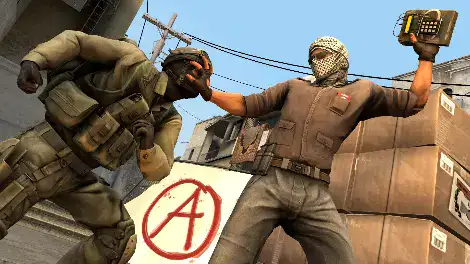Counter Terrorists vs Terrorists in Counter-Strike 2
The terms Counter-Terrorist (CT) or Terrorist (T) have been around since the very start of Counter-Strike’s long history. This team dynamic, similar to “cops and robbers,” has been embedded in gaming since before most of us can remember. While they are mostly known for their presence in CS:GO, Valorant players ended up adopting the terms non-officially. First-person shooter players often borrow the terminology from games like CS:GO, referring to attackers as Ts and defenders as CTs. But it's not just the terms; players also carry over strategies and concepts that originated in CS:GO, now CS2.

These terms extend beyond CS2. Finding a place in games like Valorant, Overwatch, and others that share the same format and knowing the terminology and strategies will boost your rank and in-game prowess in any shooter. When players mention T or CT, they're likely talking about the spawn points of attackers and defenders, creating a common language that transcends specific game titles.
Valorant enthusiasts, for example, not only refer to attackers as T, but also affectionately call the spike 'the bomb.' This terminology leads back to Counter-Strike 2, highlighting the enduring impact of these phrases in shaping the gaming lexicon.
Is it better to play as CT or T?
The answer isn't a straightforward one, as it hinges on individual player skills, team coordination, and various in-game factors, especially on maps. Each side has its strengths and weaknesses, making it a matter of personal preference and playstyle. Maps do play a significant role, but game developers, like Valve, continuously tweak and balance them to ensure a balanced experience for both CTs and Ts.
|
Why the persistent use of CT and T in FPS games? These terms originated from Counter-Strike, a game released by Valve in 1999 where players could align themselves with either the Terrorist or Counter-Terrorist team. The shorthand "CT" has since become a staple in the genre, spilling over into games like Valorant, signifying the team tasked with preventing bomb plants or defusing them. The influences in vocabulary go beyond the fundamental CT and T terms, however. Nowadays, phrases like "ninja defuse" and "nade stack" are common in shooters. |
 |
A "ninja defuse" isn't just a sneaky maneuver; it's a tactical triumph. A ninja defuse happens when a player disarms the bomb successfully without alerting the attacking team. It's a testament to skill and stealth, adding an element of surprise to the game.
There’s also the infamous "nade stack," a coordinated explosion strategy where players synchronize grenade throws for maximum impact. This maneuver isn't just about dealing damage; it's a team-centric approach to eliminating enemies or gaining a strategic upper hand. The "nade stack" exemplifies the importance of teamwork and strategic planning in these high-stakes gaming environments.
CS:GO's legacy endures by leaving terms like CT and T as integral components of gaming culture. These terms have become a universal language for FPS enthusiasts, creating a shared identity and boosting the gaming experience across different titles. There’s some comfort in knowing that no matter where gaming takes us, we will always take something with us to remember our first and fondest gaming experiences.
If you ever wondered what it's like to play with a Global Elite player, check out our CS2 Boosting services today!

GG Boost, the Best Elo Boosting Experience!
 Deutsch
Deutsch  Français
Français  Español
Español  Português
Português